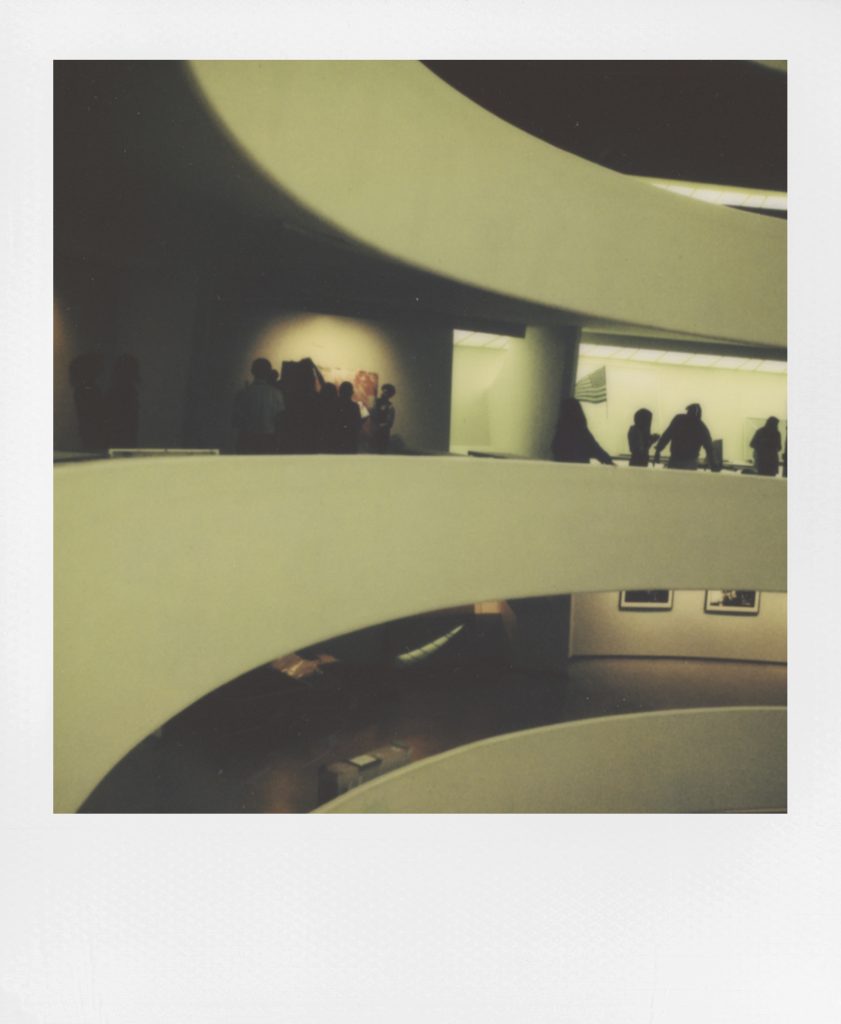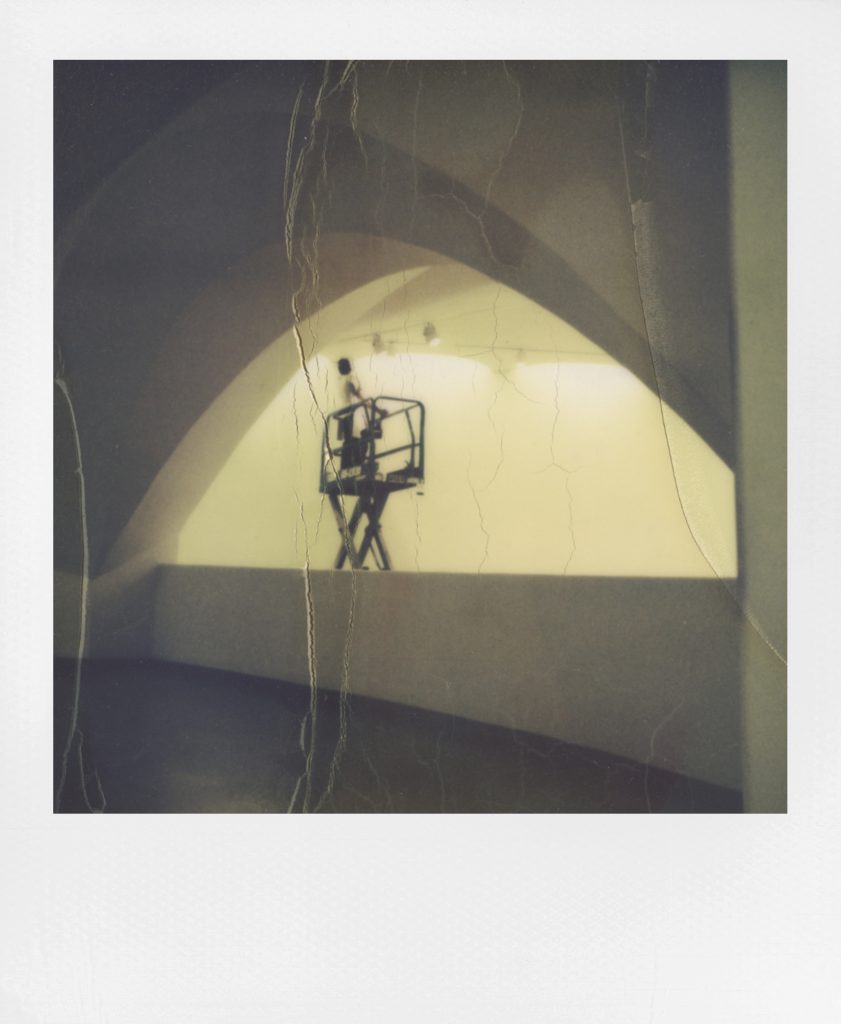Museums & Institutions
What Goes on Behind the Scenes at a Guggenheim Show? These Eye-Opening Polaroids Photos Offer a Rare Peek
The museum's exhibitions manager, Barron Preston, shot these images during the installation of "Going Dark."

The museum's exhibitions manager, Barron Preston, shot these images during the installation of "Going Dark."

Min Chen

Editor’s note: An earlier version of this article featured more Polaroid images from behind the scenes of the installation of the “Going Dark” exhibition shared by the photographer Barron Preston. These were removed at the insistence of the Guggenheim Museum, which said it had not authorized them.
Currently on view at New York’s Guggenheim Museum is “Going Dark: The Contemporary Figure at the Edge of Visibility,” a show that surveys how the self or body is rendered abstract, even obscure, in conceptual art. It brings together more than 100 works, the bulk of them created by Black and women artists. The oblique portraits of Lorna Simpson and John Edmonds are included, as are seminal pieces by Faith Ringgold and Charles White, and a luminously lit installation by Sandra Mujinga.
What’s not explicitly on view is the labor that went into organizing and installing the exhibition, that of curators, art handlers, conservators, technicians, designers, and the many other specialists who toil behind the scenes. For the Guggenheim’s exhibitions manager, Barron Preston, this work doesn’t just make up his day-to-day, but forms the subject of his ongoing photography project.
Since he joined the Guggenheim in 2021, Preston has been documenting the setup of every exhibition—from a 2022 Nick Cave survey to Sarah Sze’s recent solo show—exclusively with a Polaroid camera. Chronicling the processes behind “Going Dark” was of especial significance to him as a Black creative, he told me over Zoom.
“It’s the first show that I’ve seen that fills the [museum’s] ramps full of Black artists,” he said. “I felt that this is history, specifically at the Guggenheim, but in general, a big moment for folks like me.”
Preston’s Polaroids photographs of “Going Dark” bottle the hum of activity that goes into an exhibition installation. An art handler lays out Glenn Ligon’s “Figure” series; a painter works a corner of the High Gallery from a lift; curator Ashley James and exhibition designer Nazanin Naeini consider the placement of a David Hammons work.
“The install is probably one of the most rewarding aspects of my job,” he said. “It’s where all the planning, all the conceptualizing becomes real.”

Painter on lift in High Gallery, for “Going Dark: The Contemporary Figure at the Edge of Visibility.” Photo: Barron Preston.
While Preston’s previous shots—such as those of the Sze show, and a mock-up of a forthcoming Jenny Holzer installation—centered mostly on the artworks themselves, his images of “Going Dark” represented, he noted, “the first time that I’ve incorporated roles that are a bit less visible.”
Fixed in square format, they are scenes that seem almost contemplative, but belie what Preston termed as the “frenzy” of setting up an exhibition: “Everyone’s doing everything all at once and it always feels like we have no time.” Still, one particular Polaroid does capture that bustle through Preston’s use of double exposure: it depicts art handlers moving Charles White artworks over the span of about five minutes, their fleeting presences leaving ghostly trails.
Preston first began shooting with Polaroid’s One600 Classic model (“it’s basically like a toy,” he said), before recently moving on to the I-2 camera, which allowed him to experiment with settings and techniques like double exposures. The Polaroid format, he added, was compelling to him for its tactility as much as the way it swiftly freezes the moment.
“I like documentation and I’m constantly thinking about posterity,” he said. “A Polaroid image is an undeniable truth, where it can’t be manipulated. What you’re seeing is what it is. It’s somehow a more accurate representation of a moment in my memory.”
It is for this reason, perhaps, that Preston’s photographs aren’t overburdened with technical wizardry. He revealed he shoots from instinct and by “feeling the moment.” He refrains from using flash as artworks are often light-sensitive. The only effect in his Polaroids images is purely accidental: a yellow tint caused by the Guggenheim’s fluorescent lights.
“The images all have a slight green, yellowish hue to them. It took me about two weeks to figure out that museum lighting created this effect,” he explained, adding of the exhibition: “The central Mujinga piece on the first floor emits a neon green light, so I thought it was serendipitous. I don’t mind it. I just went with it.”
“Going Dark: The Contemporary Figure at the Edge of Visibility” is on view at the Guggenheim Museum, 1071 5th Avenue, New York, through April 7, 2024.
More Trending Stories:
Revealed: The Major Mystery Consignors of New York’s Multi-Billion-Dollar Fall Auction Season
Christie’s Pulled Two Works by a Prominent Middle Eastern Artist From Sale After a Complaint